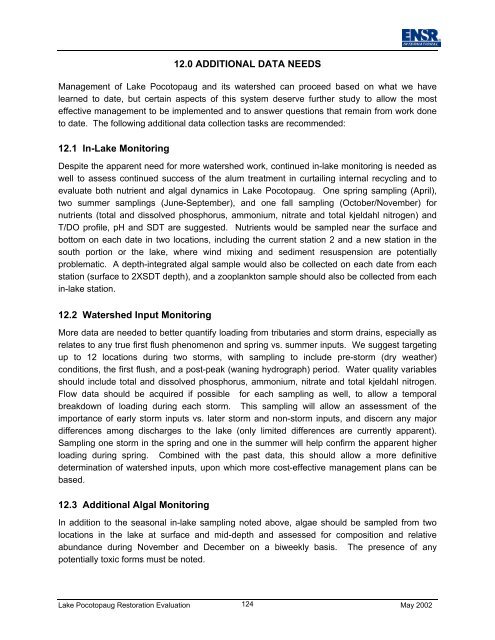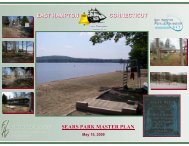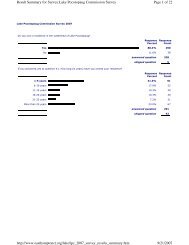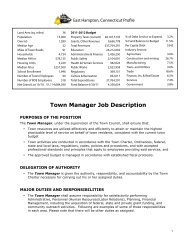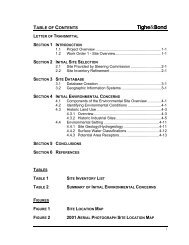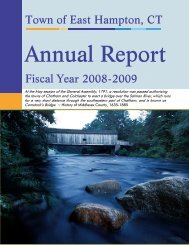Lake Pocotopaug Lake and Watershed Restoration Evaluation ...
Lake Pocotopaug Lake and Watershed Restoration Evaluation ...
Lake Pocotopaug Lake and Watershed Restoration Evaluation ...
Create successful ePaper yourself
Turn your PDF publications into a flip-book with our unique Google optimized e-Paper software.
12.0 ADDITIONAL DATA NEEDSManagement of <strong>Lake</strong> <strong>Pocotopaug</strong> <strong>and</strong> its watershed can proceed based on what we havelearned to date, but certain aspects of this system deserve further study to allow the mosteffective management to be implemented <strong>and</strong> to answer questions that remain from work doneto date. The following additional data collection tasks are recommended:12.1 In-<strong>Lake</strong> MonitoringDespite the apparent need for more watershed work, continued in-lake monitoring is needed aswell to assess continued success of the alum treatment in curtailing internal recycling <strong>and</strong> toevaluate both nutrient <strong>and</strong> algal dynamics in <strong>Lake</strong> <strong>Pocotopaug</strong>. One spring sampling (April),two summer samplings (June-September), <strong>and</strong> one fall sampling (October/November) fornutrients (total <strong>and</strong> dissolved phosphorus, ammonium, nitrate <strong>and</strong> total kjeldahl nitrogen) <strong>and</strong>T/DO profile, pH <strong>and</strong> SDT are suggested. Nutrients would be sampled near the surface <strong>and</strong>bottom on each date in two locations, including the current station 2 <strong>and</strong> a new station in thesouth portion or the lake, where wind mixing <strong>and</strong> sediment resuspension are potentiallyproblematic. A depth-integrated algal sample would also be collected on each date from eachstation (surface to 2XSDT depth), <strong>and</strong> a zooplankton sample should also be collected from eachin-lake station.12.2 <strong>Watershed</strong> Input MonitoringMore data are needed to better quantify loading from tributaries <strong>and</strong> storm drains, especially asrelates to any true first flush phenomenon <strong>and</strong> spring vs. summer inputs. We suggest targetingup to 12 locations during two storms, with sampling to include pre-storm (dry weather)conditions, the first flush, <strong>and</strong> a post-peak (waning hydrograph) period. Water quality variablesshould include total <strong>and</strong> dissolved phosphorus, ammonium, nitrate <strong>and</strong> total kjeldahl nitrogen.Flow data should be acquired if possible for each sampling as well, to allow a temporalbreakdown of loading during each storm. This sampling will allow an assessment of theimportance of early storm inputs vs. later storm <strong>and</strong> non-storm inputs, <strong>and</strong> discern any majordifferences among discharges to the lake (only limited differences are currently apparent).Sampling one storm in the spring <strong>and</strong> one in the summer will help confirm the apparent higherloading during spring. Combined with the past data, this should allow a more definitivedetermination of watershed inputs, upon which more cost-effective management plans can bebased.12.3 Additional Algal MonitoringIn addition to the seasonal in-lake sampling noted above, algae should be sampled from twolocations in the lake at surface <strong>and</strong> mid-depth <strong>and</strong> assessed for composition <strong>and</strong> relativeabundance during November <strong>and</strong> December on a biweekly basis. The presence of anypotentially toxic forms must be noted.<strong>Lake</strong> <strong>Pocotopaug</strong> <strong>Restoration</strong> <strong>Evaluation</strong> 124May 2002


